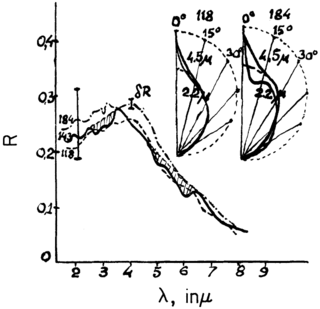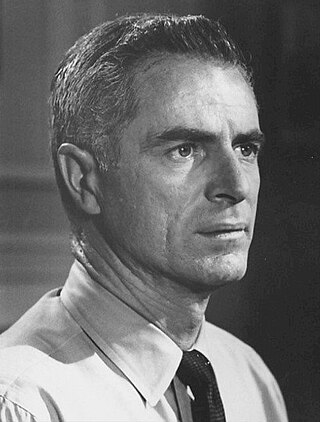
The Moon is Earth's only natural satellite. It orbits at an average distance of 384,400 km (238,900 mi), about 30 times the diameter of Earth. Over time Earth's gravity has caused tidal locking, causing the same side of the Moon to always face Earth. Because of this, the lunar day and the lunar month are the same length, at 29.5 Earth days. The Moon's gravitational pull – and to a lesser extent, the Sun's – are the main drivers of Earth's tides.

Space colonization is the use of outer space or celestial bodies other than Earth for permanent habitation or as extraterrestrial territory.

The giant-impact hypothesis, sometimes called the Big Splash, or the Theia Impact, is an astrogeology hypothesis for the formation of the Moon first proposed in 1946 by Canadian geologist Reginald Daly. The hypothesis suggests that the Early Earth collided with a Mars-sized dwarf planet of the same orbit approximately 4.5 billion years ago in the early Hadean eon, and the ejecta of the impact event later accreted to form the Moon. The impactor planet is sometimes called Theia, named after the mythical Greek Titan who was the mother of Selene, the goddess of the Moon.

Destination Moon is a 1950 American Technicolor science fiction film, independently produced by George Pal and directed by Irving Pichel, that stars John Archer, Warner Anderson, Tom Powers, and Dick Wesson. The film was distributed in the United States and the United Kingdom by Eagle-Lion Classics.

A Moon landing or lunar landing is the arrival of a spacecraft on the surface of the Moon, including both crewed and robotic missions. The first human-made object to touch the Moon was Luna 2 in 1959.

Lunar water is water that is present on the Moon. Diffuse water molecules in low concentrations can persist at the Moon's sunlit surface, as discovered by the SOFIA observatory in 2020. Gradually, water vapor is decomposed by sunlight, leaving hydrogen and oxygen lost to outer space. Scientists have found water ice in the cold, permanently shadowed craters at the Moon's poles. Water molecules are also present in the extremely thin lunar atmosphere.

Timothy Joseph O'Connor was an American character actor known for his prolific work in television, although he made only a few appearances after the early 1990s. Before moving to California, he lived on an island in the middle of Glen Wild Lake, located in Bloomingdale, New Jersey, 30 miles from Manhattan. O'Connor specialized in playing officials, military men, and police officers.
"The Architects of Fear" is an episode of the original The Outer Limits television show. It first aired on September 30, 1963, during the first season.

Marianna Hill is an American actress who is known for her starring roles in the Western films El Condor (1970) and High Plains Drifter and the cult horror film Messiah of Evil, as well as many roles on television series in the 1960s and 1970s. She was sometimes credited as Mariana Hill.
"Don't Open Till Doomsday" is an episode of the original The Outer Limits television show. It first aired on 20 January 1964, during the first season.

"The Children of Spider County" is an episode of the original The Outer Limits television show. It first aired on 17 February 1964, during the first season.
"Specimen: Unknown" is an episode of the original The Outer Limits television show. It first aired on 24 February 1964, during the first season.
"Fun and Games" is an episode of the original The Outer Limits television show. It first aired on 30 March 1964, during the first season.
"The Special One" is an episode of the original The Outer Limits television show. It first aired on 6 April 1964, during the first season.
"The Invisible Enemy" is an episode of the original The Outer Limits television show. It first aired on October 31, 1964, during the series' second season.
"Wolf 359" is an episode of the original The Outer Limits television show. It first aired on 7 November 1964, during the second season. The title is derived from a star of the same name located relatively near Earth.
"Keeper of the Purple Twilight" is an episode of the original The Outer Limits television show. It first aired on 5 December 1964, during the second season.

Selenography is the study of the surface and physical features of the Moon. Like geography and areography, selenography is a subdiscipline within the field of planetary science. Historically, the principal concern of selenographists was the mapping and naming of the lunar terrane identifying maria, craters, mountain ranges, and other various features. This task was largely finished when high resolution images of the near and far sides of the Moon were obtained by orbiting spacecraft during the early space era. Nevertheless, some regions of the Moon remain poorly imaged and the exact locations of many features are uncertain by several kilometers. Today, selenography is considered to be a subdiscipline of selenology, which itself is most often referred to as simply "lunar science." The word selenography is derived from the Greek word Σελήνη and γράφω graphō, meaning to write.
"Missing Link" is the 20th episode of the first series of Space: 1999. The screenplay was written by Edward di Lorenzo; the director was Ray Austin. The final shooting script is dated 5 April 1974. Live-action filming took place Monday 22 April 1974 through Thursday 9 May 1974, with one day of second-unit filming on 22 July 1974.

Bill Nagy (1921–1973) was a Canadian-born film and television actor who settled and worked in Britain. He began working on the London stage, appearing in the West End production of South Pacific.











